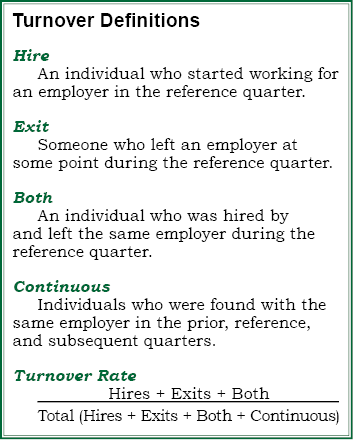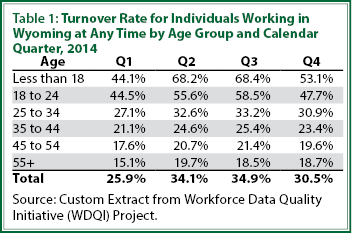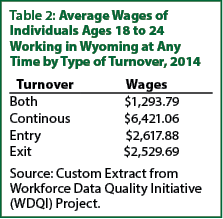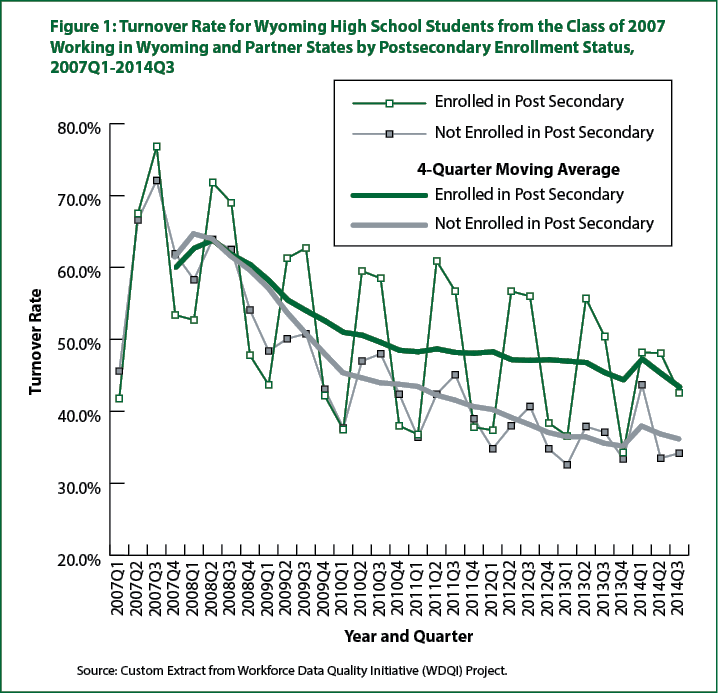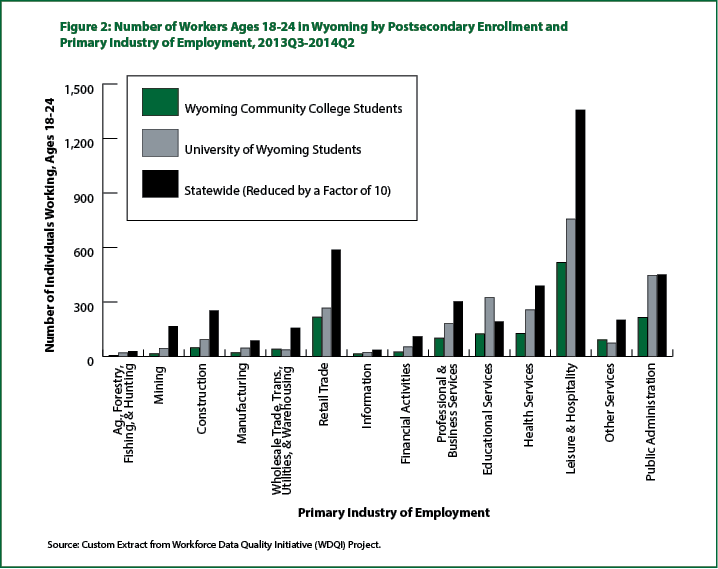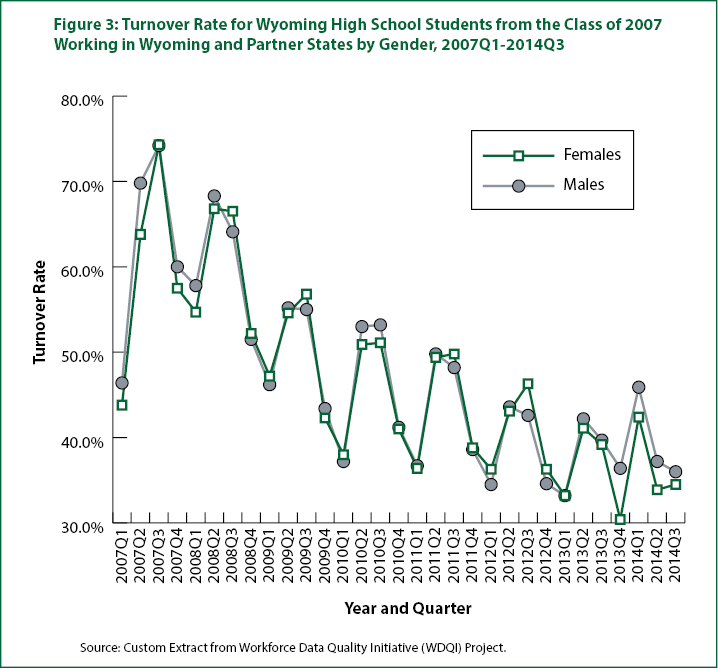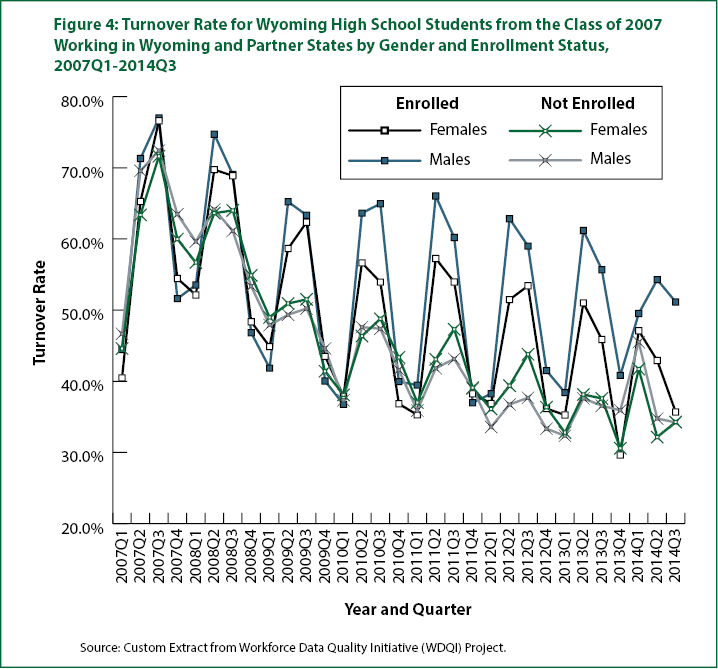
WE Connect: Employment, Earnings, and Postsecondary Enrollment of Wyoming High School Students
Part 4: Turnover Rate and Labor Market Outcomes for Wyoming High School Students
Upon graduating high school, students face many decisions that affect their labor market outcomes. This publication looks at turnover among students who were high school seniors in the Wyoming high school Class of 2007 and were found working or, if they enrolled in postsecondary education, were enrolled in a college or university in Wyoming or one of the 11 states with which Research & Planning (R&P) has a data sharing agreement (Alaska, Colorado, Idaho, Montana, Nebraska, New Mexico, Ohio, Oklahoma, South Dakota, Texas, and Utah).
Job turnover represents the relationship between workers and their employers in a reference quarter (see Turnover Definitions; Glover, 2001). Rates closer to 100% represent fewer continuous employees and higher instability, while rates closer to 0% indicate more continuous employees and more stability.
Job turnover tends to decrease with age. Table 1 shows the difference in turnover rate among age groups for all individuals working in Wyoming at any time in 2014 by quarter. The 55 and older age group (55+) had the lowest turnover rate (between 15.1% and 19.7%) while young adults had the highest turnover rates. In 2014, the range of the quarterly turnover rate for adults ages 18 to 24 was between 44.5% in first quarter (Q1) and 58.5% in third quarter (Q3). The turnover rate dropped as much as 25.3 percentage points (Q3) between the 18 to 24 and 25 to 34 age segments, as the older group was more likely to be employed continuously.
Harris (2015) noted that job instability is highest for young adults near the age of high school completion, and found this high instability could be a result of life events such as marriage, household formation, and having children. The number of people between the ages of 18 and 21 working in Wyoming has declined over the last decade and this age group has a higher turnover rate, possibly due to the lack of human capital (Hammer & Holmes, 2015).
High instability, whether due to lack of experience, starting a family, or choosing to enroll in postsecondary education, is associated with lower earnings. In 2014, the average wage for workers between the ages of 18 and 24 with continuous employment was almost $4,000 more in one quarter than for those starting a new job or leaving a job (see Table 2). This publication tracks the Class of 2007 from the 2006/07 12th grade through third quarter 2014 (2014Q3). For conversational purposes, this means tracking a cohort of 18-year-olds for seven years until they are age 25.
In the years immediately following high school graduation, Wyoming students who enroll in postsecondary education tend to earn less than those who do not enroll in postsecondary education (Gallagher, Glover, Hammer, Holmes, and Moore, 2015). For example, for the Class of 2007, those who enrolled in postsecondary education earned $2,899 less than those who did not enroll in 2007, and $5,759 less in 2008 (see Table 3). The difference in wages could be a result of a higher turnover rate for postsecondary students rather than a lack of human capital. The difference in wages could also be attributed to college students working fewer hours than their non-student peers.
Figure 1 shows the turnover rate of the 2007 senior class by enrollment in postsecondary education from 2007Q1 through the 2014Q3. During the summer quarters before 2014, hire and exit activity for workers enrolled in postsecondary education reached above 55.0% and dropped at least 20.0 percentage points during the winter quarters, while the difference between the turnover rate in summer and winter quarters for non-enrolled workers was much less. This indicates that the turnover rate for workers enrolled in postsecondary education has much higher seasonality than that of workers not enrolled. This may be due to students leaving their jobs in their college town and obtaining summer employment in their home town.
The industries in which students find work may also contribute to the seasonality of the turnover rate. In her study of University of Wyoming and Wyoming community colleges, Faler (2015) found that most students between the ages of 18 and 24 worked in leisure & hospitality, public administration, educational services, and retail trade (see Figure 2). Leisure & hospitality and retail trade tend to offer seasonal work, especially in the summer months.
After 2011, the turnover rate for students from the 2007 senior class enrolled in postsecondary education ranged from less than 40% in first and fourth quarters to more than 55% in second and third quarters. During this time, the four-quarter moving average showed much slower decline in turnover rate than that of workers who were not enrolled in postsecondary education, indicating a more rapid increase in job stability for workers who are not currently enrolled in a postsecondary institution in Wyoming or its partner states.
Figure 1 also shows the turnover rate for the students from the 2007 senior class who were not enrolled in postsecondary education in the reference quarter. Once a student graduates or chooses not to return to a postsecondary institution, that individual will no longer affect the turnover rate for students enrolled in postsecondary education. Instead, an individual who does not return to postsecondary education and works will affect the turnover rate for the portion of the 2007 senior class that is not currently enrolled in a university or community college. Switching between “not enrolled in postsecondary education and working” and “enrolled in postsecondary education and working” occurs continuously as individuals in the workforce enroll in and withdraw from postsecondary education within Wyoming and the partner states over time.
The turnover rate for those not enrolled in postsecondary education shows much less fluctuation and decreases much faster over time than the turnover rate for students enrolled in postsecondary education. From 2008Q2 to 2010Q1, the turnover rate for the 2007 senior class not enrolled in postsecondary education dropped from 63.9% in 2008Q2 to 37.7% in 2010Q1. There was a slight increase in turnover rate from 48.4% in 2009Q1 to 50.1% in 2009Q2; this slight increase, followed by a significant decrease from 50.8% in 2009Q3 to 37.7% in 2010Q1, could be the result of students graduating from community colleges and entering continuous employment.
After 2010, the turnover rate for the 2007 senior class not enrolled in postsecondary education continued to decrease, indicating increased stability, while the fluctuations between quarters over the year indicated less seasonality. Industries in which individuals ages 18 to 24 were employed, whether they were enrolled in postsecondary education or not, were leisure & hospitality, retail trade, public administration, and professional & business services. While employment in retail trade and leisure & hospitality can be seasonal, employment in public administration and professional & business services tends to be more stable and may provide more long-term continuous employment.
Figure 3 illustrates turnover for the Class of 2007 12th graders in all 12 states. Turnover rates for males and females were similar from 2007Q1 to 2013Q3. The turnover rate between males and females may be similar when not taking into account postsecondary education enrollment; however, Figure 4 shows the comparison of males and females enrolled and not enrolled in postsecondary education. Males and females enrolled in a community college or university in Wyoming and partner states experienced larger drops and increases in turnover rate each quarter, often about 25%, compared to those who were not enrolled. The turnover rate for enrolled males reached as high as 77.0% in 2007Q3 to as low as 36.8% in 2010Q1. Faler’s (2015) study of work and enrollment at UW and community colleges found that males between ages 18 and 24 worked in leisure & hospitality, public administration, educational services, and retail trade. Females enrolled in postsecondary education did not experience a turnover rate as high as that of enrolled males except during 2007. Enrolled females saw a decrease in turnover rate from 62.4% in 2009Q3 to 37.9% in 2010Q1. After 2011Q2, the turnover rate for enrolled females remained below 57% with a downward trend. Females between the ages of 18 and 24 enrolled at UW and the community colleges worked in leisure & hospitality, public administration, health services, and educational services (Faler, 2015).
Figure 4 also shows the turnover rate of males and females from the 2007 senior class not enrolled in postsecondary education. The rates for non-enrolled males and females were similar; however, the turnover rate for males was slightly lower. After 2010Q3, the turnover rate for females remained below 50% while the turnover rate for males remained below 47% and continued to steadily decline over time.
According to Workforce Data Quality Initiative Report No. 1 (Gallagher, Glover, Hammer, Holmes, & Moore, 2015), Wyoming high school seniors who choose to immediately enter the workforce earn higher wages than those who enroll in postsecondary education. There are fewer youth working in Wyoming (Hammer & Holmes, 2015), and these lower wages for postsecondary students are not necessarily due to the lack of human capital. Rather, one factor likely contributing to lower wages for young adults is high instability, possibly due to major life decisions, including marriage, household formation, and enrollment in postsecondary education. Also, enrollment in postsecondary education includes possible relocation to the college town, resulting in seasonal work in the summer, or a necessity to find employment in seasonal industries to accommodate school schedules.
In conclusion, it is likely that a lack of human capital is not alone in lowering wages of young adults. Instead, instability brought on by enrollment in a university or community college may contribute to lower wages for postsecondary students.
References
Faler, K. (2015). WE Connect, Part 2: Opportunity Cost of Pursuing a Postsecondary Education in Wyoming. August, 2015. Department of Workforce Services, Research & Planning. Casper, WY.
Gallagher, T., Glover, T., Hammer, L., Holmes, M., & Moore, M. (2015, April). Workforce Data Quality Initiative Report No. 1 for Wyoming: School Attendance and Employment, 2006 to 2013. Wyoming Department of Workforce Services, Research & Planning, Casper, WY.
Glover, W. (2001). Turnover Analysis; Definitions, Process, and Quantification. Retrieved August 7, 2015, from http://doe.state.wy.us/LMI/w_r_research/Turnover_Methodology.pdf
Hammer, L., & Holmes, M. (2015). Fewer youth working in Wyoming. Wyoming Labor Force Trends, 52(3). Retrieved August 7, 2015, from http://doe.state.wy.us/LMI/trends/0315/toc.htm
Harris, P. (2015). Youth transitions: Life events and labor market behavior. Wyoming Labor Force Trends, 52(5). Retrieved August 11, 2015, from http://doe.state.wy.us/LMI/trends/0515/a1.htm
